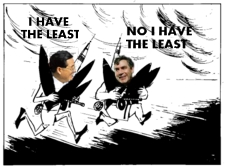Nuclear Arms Racing in the Post-Cold War Era: Who is the Smallest?
 |
|
China and the Uniked Kingdom have started a new arms race over who has the smallest nuclear weapons arsenal. |
By Hans M. Kristensen
Mine is smaller! No, mine is smaller!!
China and the United Kingdom have started a new type of nuclear arms race for the honor to have the smallest number of nuclear weapons.
In April 2004, the Chinese Foreign Ministry declared in the fact sheet China: Nuclear Disarmament and Reduction of: “Among the nuclear-weapon states, China…possesses the smallest nuclear arsenal.”
In May 2007, British Defense Minister Des Browne stated in a written response to a parliamentary question that the United Kingdom has “the smallest stockpile of any of the nuclear weapon states recognised under the NPT.”
Apparently, the race is on for who is the smallest.
So Who Is The Smallest Nuclear Power?
The size of the nuclear weapons inventory of both countries is secret, but it is possible to make best estimates.
Britain announced in December 2006 that it had reduced the number of “operationally available warheads” from fewer than 200 to “less than 160.” The gesture was somewhat hollow, however, because Britain hasn’t had room for more than 144 warheads on its Trident D5 missiles for years. Moreover, the language hints that Britain has more nuclear warheads in storage. Assuming it retains a small reserve, the total British stockpile is probably around 200 warheads.
The British government has stated that the single SSBN on patrol at any given time carries “up to 48” warheads, a statement that partly reflects that some of the missiles have been given a “substrategic” mission, probably with only one warhead each. Depending on the number of substrategic mission missiles carried, the actual loading of the patrolling submarine probably is 36-44 warheads. Assuming a similar loading for the other two SSBNs for which there are missiles available, the estimated number of warheads needed for the British SSBN fleet since the substrategic mission first became operational in 1996 is 108-132 warheads.
The Chinese government’s statement that it possesses the smallest nuclear arsenal among the nuclear-weapon states is different than the British statement. First, the Chinese statement refers to the “arsenal” rather than stockpile described by the British statement. It is unclear what the Chinese mean by “arsenal” – whether it refers to the entire stockpile or only operational warheads. Second, the statement refers to “the nuclear-weapon states,” rather than the NPT-declared nuclear weapon states (Britain, China, France, Russia, United States), and thus appears to include India and Pakistan as well. Yet elsewhere in the statement, the foreign minister uses the term “nuclear-weapon states” to refer to Britain, China, France, Russia, and the United States. Based on publicly available information and assessments made by the U.S. Intelligence Community, China is estimated to have approximately 150 operational nuclear weapons and a total stockpile of roughly 200 warheads. Only about 100 of these may actually be deployed with the delivery systems, although few (if any) of the warheads are thought to be mated on the weapon.
|
|
 |
|
Britain and China both claim to have the lowest number of nuclear weapons of the original five nuclear weapon states. Both refuse to say how many they have. In reality, the two countries are estimated to have about the same total number of nuclear warheads, but the numbers can very considerably depending on which part of the posture is presented. |
The two postures differ significantly. China does not have a permanent deployment of nuclear weapons at sea, and most (if not all) of China’s land-based missiles are thought to be deployed without the nuclear warheads installed. Unlike Britain, moreover, China has a no-first-use policy for its nuclear weapons.
In the future, however, China may have to revisit its statement about its nuclear weapons inventory. Whereas the British stockpile has declined an is unlikely to increase in the future, the Chinese stockpile may be increasing some in the next decade.
Confidence Reaffirmed (Silly Secrecy Too)
The statements made by the two countries have revealed a curious phenomenon: both apparently are confident that they know how many nuclear weapons the other has. Indeed, confidence appears to be so high that both are willing to say so in public.
This is curious because both countries insist that the size of their nuclear stockpiles must be kept a secret, or national security would be jeopardized. But if they both know the size of the other’s arsenal, who are they keeping it secret from?
Background: Britain’s Next Nuclear Era | Chinese Nuclear Forces and U.S. Nuclear War Planning | British Nuclear Forces, 2005
While it is reasonable for governments to keep the most sensitive aspects of nuclear policies secret, the rights of their citizens to have access to general knowledge about these issues is equally valid so they may know about the consequences to themselves and their country.
Nearly one year after the Pentagon certified the Sentinel intercontinental ballistic missile program to continue after it incurred critical cost and schedule overruns, the new nuclear missile could once again be in trouble.
“The era of reductions in the number of nuclear weapons in the world, which had lasted since the end of the cold war, is coming to an end”
Without information, without factual information, you can’t act. You can’t relate to the world you live in. And so it’s super important for us to be able to monitor what’s happening around the world, analyze the material, and translate it into something that different audiences can understand.